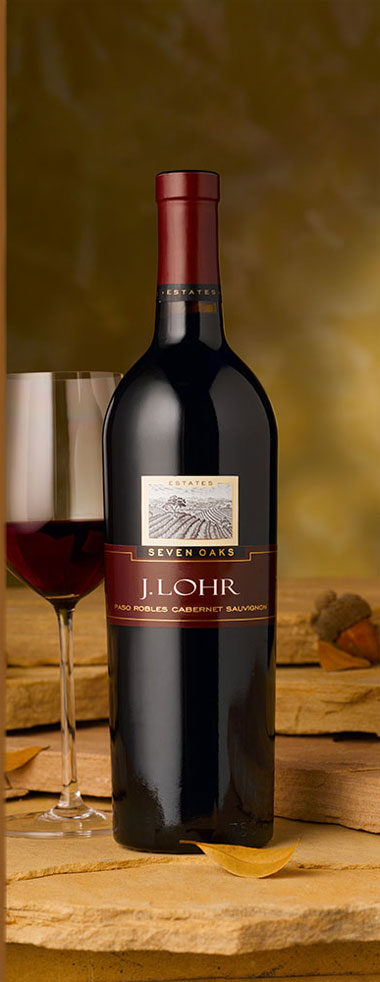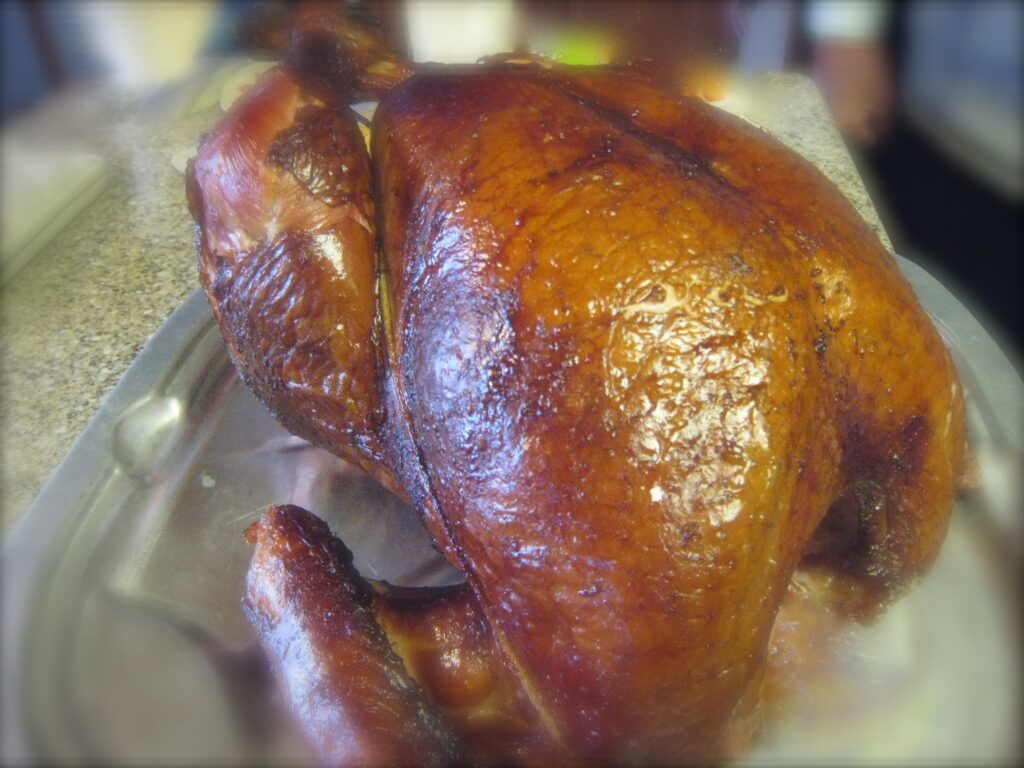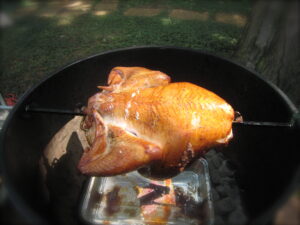We had a lovely day.
Meal info to come. Maybe. 🙂
This is the third year that I’ve cooked our Thanksgiving turkey on the Weber Kettle. It was the first time that I’ve done it without using the rotisserie attachment, and it turned out beautifully.
We dry brined the bird Wednesday evening with a mixture of kosher salt, cracked black pepper, Turbinado sugar, garlic powder and Herbs de Provence. I stuffed the turkey with onions and Mandarin oranges, then sprayed it with olive oil before placing it on the preheated grill over a drip pan containing a bottle of inexpensive Cabernet Sauvignon. Hickory and Cherry chunks provided the smoke.
I started it breast side down, and flipped it over about an hour into cooking. The grill was running more than 400 F to start, and eventually leveled off to around 300. For a 13 pound bird, I’d estimated that it would take around 2 1/2 hours at these temperatures, and that was right on the money. The lowest temp in the breast was around 160 when we brought the turkey in and covered it with a foil tent to rest.
I strained the pan drippings and used them to make a simple gravy, starting with a roux and adding seasonings and some stock.
We served the J. Lohr Cab Sauv with the meal, and it was delicious, but I think I’d go with a Pinot Noir next time.
 When planning a wine pairing for Thanksgiving Dinner, I’ve always heard of the ABC rule: anything but Cabernet Sauvignon. This year, I’m breaking the rule.
When planning a wine pairing for Thanksgiving Dinner, I’ve always heard of the ABC rule: anything but Cabernet Sauvignon. This year, I’m breaking the rule.
The issue is that turkey is not thought to contain enough fat or flavor to balance against the tannins of the Cab Sauv. By smoking the turkey on the Weber kettle grill, we ought to have the flavor part of the equation covered. I also plan to make gravy from the drippings, which should add some richness at table.
The wine will be a 2010 Seven Oaks from J. Lohr, splash decanted to soften the tannins a bit, a trick I learned to tame Malbec that grips so hard it pulls your tonsils out.
We’ll report back later in the week.

My apologies for not posting this earlier. I’m sure that you’ve been waiting impatiently to hear how our Thanksgiving Turkey turned out on the rotisserie.
I did make some adjustments from the trial run, using a fresh turkey, taking care to properly dry brine and stuff the bird, using hickory wood for smoke, and icing the breast prior to cooking to help keep it rarer. After the charcoal was nearly gone under the rotisserie, I moved the turkey to the gas grill to finish cooking so that I could use a probe thermometer to monitor doneness more easily.
In short, it turned out really well. Here are just a couple of observations.
1) I’m not sure that I’d spend the money on a fresh bird again. This one turned out better than the trial run bird, but I’m not sure that it can be attributed to a fresh bird. I expected it to be “out of this world” better than any turkey I’d ever tasted, and it just wasn’t. Nothing wrong with it, but nothing notable in texture or taste that is distinctive to it not having been frozen. If a frozen bird is good enough for Alton Brown, I’ll save myself $60 next year.
2) My wife thought this was the best turkey she’d ever tasted. My father-in-law thought that the dark meat was a little dry. I thought that the doneness and texture was perfect, but it was missing a savoriness for me. This may be because I’m used to turkeys that come “pre-basted.” We’ll see if next time the combination of pre-basting for flavor and my own dry brining for additional flavor and texture will strike the right balance. The worst thing you can say about a Butterball or other pre-basted bird is that you’re essentially paying for brine. As cheap as supermaket birds are, I won’t object to that.
Part of the issue may be that I’m comparing the rotisserie turkey to rotisserie chicken, which always seems to turn out mouth-watering delicious. I want the turkey to be like that. Guess we’ll just have to keep working at it.
Or maybe I should cook chickens for Thanksgiving next year.

In preparation for this year’s Thanksgiving Dinner, I roasted a whole turkey on the rotisserie over the weekend. In some ways, this is one of the most challenging things to cook, since it’s difficult to get the dark meat done enough without overcooking the breast.
Overall, it turned out just “alright.” Having done a marvelous job with a turkey breast awhile back, and a series of awesome whole chickens, I expected this to be over-the-top delicious. It certainly wasn’t bad, especially for a first attempt, but there are several things I would do differently next time.
1) Use a fresh turkey. The frozen turkey I cooked was “pre-basted.” This sounds like it would be a good thing, but it’s actually not. The addition of a brine solution prior to freezing actually changes the texture and taste of the bird in a way that is inferior to proper dry brining. For Thanksgiving, I’ll look for a locally raised fresh turkey.
2) Take more care with the seasoning and brining. Because the turkey was pre-basted, I didn’t want to overdo my own seasoning, particularly the salt. I limited my efforts to a little kosher salt, black pepper and herbs de provence rubbed on the skin a couple hours prior to roasting. I also didn’t stuff the cavity, thinking that this was a “dry run” anyway, and the additional aromatics wouldn’t add much. Next time, I’ll take care to properly dry brine a fresh turkey the day before, and to add plenty of citrus, onions, garlic, etc. to the cavity before cooking. My wife usually works some olive oil under the skin just prior to putting the bird in the oven as well. Although the rotisserie helps to keep food moist through self-basting, we may try her trick as well.
3) Choose your smoke wisely. I’ve been on a Cherry wood kick lately, loving the subtly sweet flavor it added to pork ribs and beef roast. In the case of turkey, I think a bolder smoke flavor would have been nice. I’ll likely use Apple, Hickory, or a mixture of the two next time.
4) I need an ice pack. One of the tricks Mike Vrobel suggests when roasting turkey on the rotisserie is to put an ice pack on the breast while it comes to room temperature before going on the grill. This has the effect of increasing the cooking time for the white meat, and allowing the legs and thighs to get up to well done without overcooking the breast. It’s listed as an “optional” step in his instructions, but I’ll definitely use it next time. The breast turned out alright, but the dark meat could have cooked just a bit longer to achieve “fall off the bone” tenderness.
A friend of mine sensed my disappointment in describing the meal as “alright” and commented that every meal doesn’t have to be a masterpiece. I suppose that’s right, although as much time and effort as goes into this particular dish, I’ll want to get it perfect next time. I think the adjustments mentioned above will make it worthy of our Thanksgiving table.
Copyright © 2026 Noebie Digital Media · Powered by WordPress and the Genesis Framework